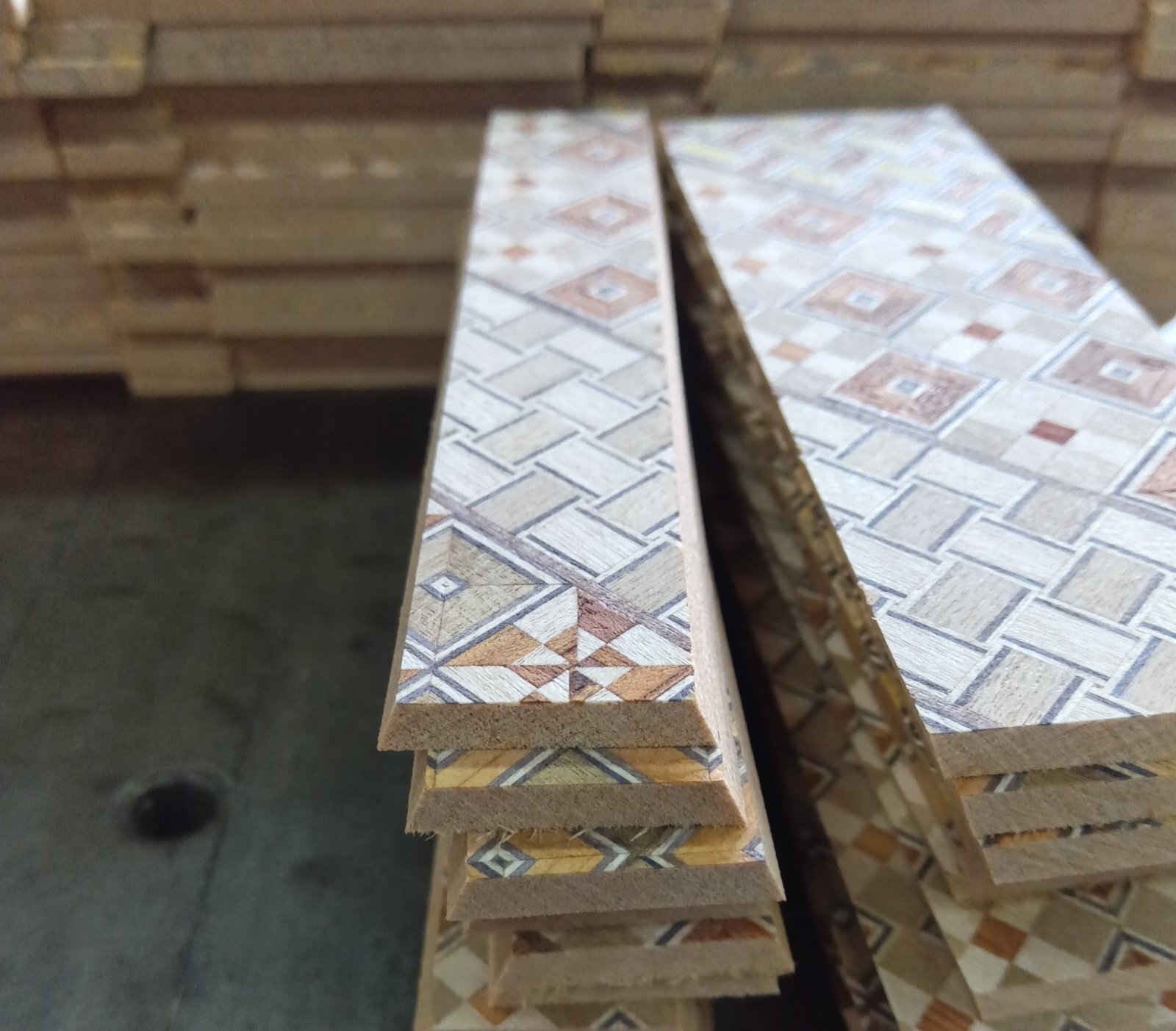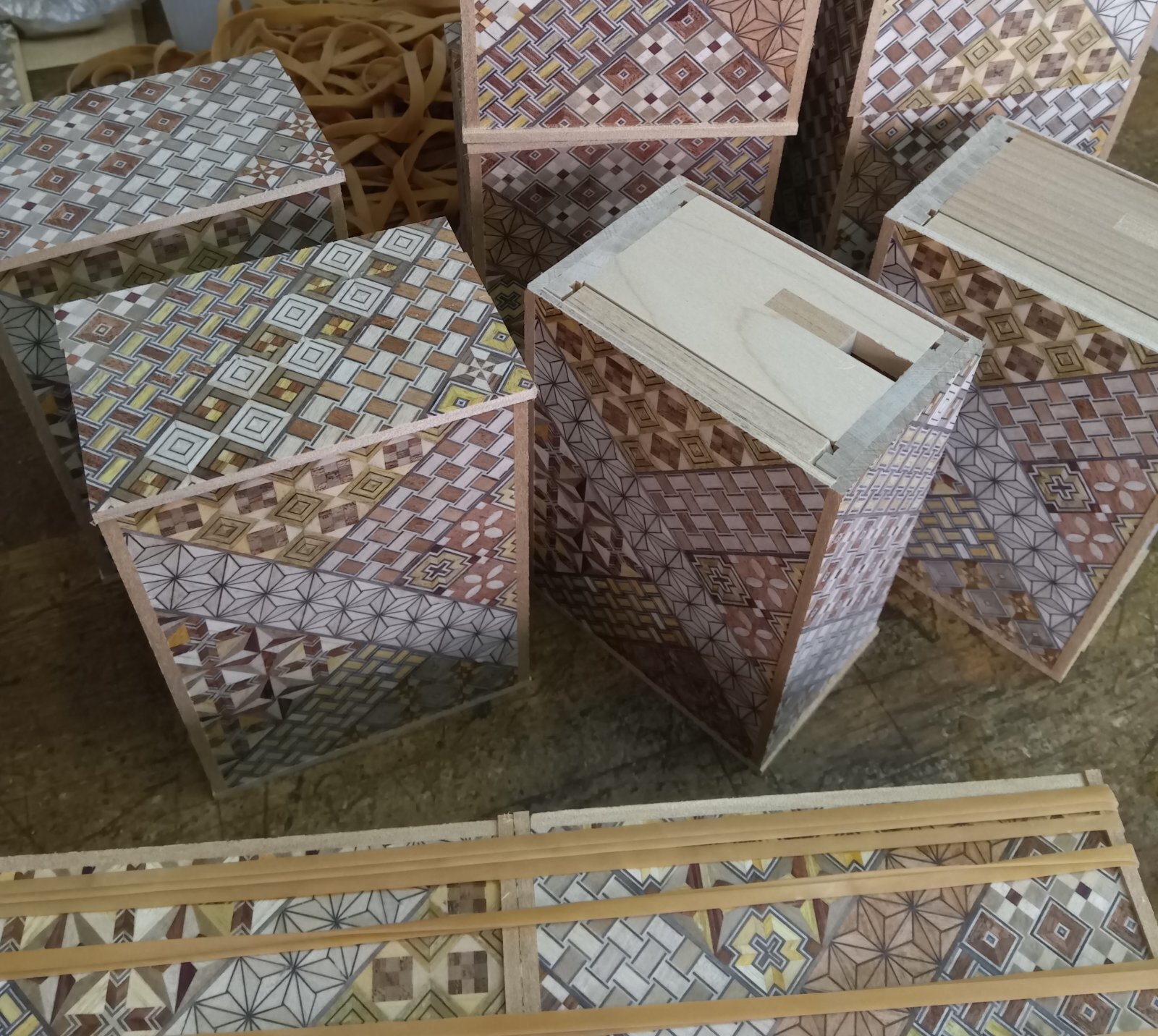Kannuki and glue
I’ve made progress on several tasks over the weekend, but today I’ll write about the process of attaching the Aruki panel (kannuki panel) for the 5-sun 27-step Japanese puzzle box. In the photo, you can see the Kannuki panel (Slide key panel), which has been cut into three pieces, along with the section where it's being attached. This process involves cutting a single panel into three parts and attaching them to the Aruki panel including a "bocchi".
When attaching the three cut pieces to the aruki panel, they must be applied in a way that prevents them from sticking to each other. The method of applying glue varies from craftsman to craftsman. Some prefer to apply it evenly across the surface to ensure a strong bond, while others apply just a few dots of glue. It seems that many craftsmen in the past used the dot method. I’ve seen broken old Japanese puzzle boxes several times, and in many cases, the panels were attached with only a small amount of glue. This was likely done to make it easier to peel off the panels later for repair if the mechanism malfunctioned.
However, at that time, it wasn’t the modern wood glue we use today, but rather "Nikawa", an adhesive made by boiling animal bones and skin. Since "Nikawa" could be easily removed with heat or impact, it allowed for easier repair of the boxes when needed.
Nikawa was commonly used until about 20 to 30 years ago. When I was in my 20s and 30s, I often saw older craftsmen in their workshops heating nikawa in a pot and using it as glue. Since they had been using nikawa since they were young, many of them continued to work with it even after modern wood glue became widespread.
Modern wood glue, even in small amounts, has a very strong adhesive power, making it difficult to remove. Therefore, using only a small amount of glue is now a technique used to prevent the panels from warping. This is because the moisture in the glue can cause the wood panel to warp.
When attaching this kannuki panel, I also use the method of applying small dots of glue. Modern wood glue is water-based, so it contains more moisture, which allows it to penetrate the wood fibers and create a strong bond. However, this also makes the panels more prone to warping. Therefore, I use a type of glue with as little moisture as possible. Attaching the three cut panels requires experience, and since the bonding surface is very small, even now, the glue occasionally seeps out and causes the mechanism to stick😂 In such cases, I rely on my experience to carefully remove the excess glue and ensure the mechanism works smoothly again.
The attached Kannuki panels are secured with rubber bands, as shown in the photo, and left to set overnight.
When attaching the three cut pieces to the aruki panel, they must be applied in a way that prevents them from sticking to each other. The method of applying glue varies from craftsman to craftsman. Some prefer to apply it evenly across the surface to ensure a strong bond, while others apply just a few dots of glue. It seems that many craftsmen in the past used the dot method. I’ve seen broken old Japanese puzzle boxes several times, and in many cases, the panels were attached with only a small amount of glue. This was likely done to make it easier to peel off the panels later for repair if the mechanism malfunctioned.
However, at that time, it wasn’t the modern wood glue we use today, but rather "Nikawa", an adhesive made by boiling animal bones and skin. Since "Nikawa" could be easily removed with heat or impact, it allowed for easier repair of the boxes when needed.
Nikawa was commonly used until about 20 to 30 years ago. When I was in my 20s and 30s, I often saw older craftsmen in their workshops heating nikawa in a pot and using it as glue. Since they had been using nikawa since they were young, many of them continued to work with it even after modern wood glue became widespread.
Modern wood glue, even in small amounts, has a very strong adhesive power, making it difficult to remove. Therefore, using only a small amount of glue is now a technique used to prevent the panels from warping. This is because the moisture in the glue can cause the wood panel to warp.
When attaching this kannuki panel, I also use the method of applying small dots of glue. Modern wood glue is water-based, so it contains more moisture, which allows it to penetrate the wood fibers and create a strong bond. However, this also makes the panels more prone to warping. Therefore, I use a type of glue with as little moisture as possible. Attaching the three cut panels requires experience, and since the bonding surface is very small, even now, the glue occasionally seeps out and causes the mechanism to stick😂 In such cases, I rely on my experience to carefully remove the excess glue and ensure the mechanism works smoothly again.
The attached Kannuki panels are secured with rubber bands, as shown in the photo, and left to set overnight.

